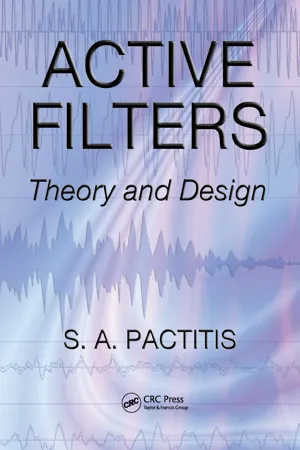
- 288 pages
- English
- ePUB (mobile friendly)
- Available on iOS & Android
About This Book
Using an accessible yet rigorous approach, Active Filters: Theory and Design highlights the essential role of filters, especially analog active filters, in applications for seismology, brainwave research, speech and hearing studies, and other medical electronics. The book demonstrates how to design filters capable of meeting a given set of specifications. Recognizing that circuit simulation by computer has become an indispensable verification tool both in analysis and in design, the author emphasizes the use of MicroCap for rapid test of the filter. He uses three basic filter types throughout the book: Butterworth, Chenyshev, and Bessel. These three types of filters are implemented with the Sallen-Key, infinite gain multiple feedback, state-variable, and biquad circuits that yield low-pass, high-pass, band-pass, and band-reject circuits. The book illustrates many examples of low-pass, high-pass, band-pass, and notch active filters in complete detail, including frequency normalizing and denormalizing techniques. Design equations in each chapter provide students with a thorough grounding in how to implement designs. This detailed theoretical treatment gives you the tools to teach your students how to master filter design and analysis.
Frequently asked questions
Information
1 | Introduction |
(1.1) |
Table of contents
- Cover
- Half Title
- Title Page
- Copyright Page
- Dedication
- Table of Contents
- Chapter 1 Introduction
- Chapter 2 Sallen–Key Filters
- Chapter 3 MultiFeedback Filters
- Chapter 4 Filters with Three Op-Amps
- Chapter 5 Sensitivity
- Chapter 6 Filters with GIC
- Chapter 7 OTA Filters
- Chapter 8 Switched Capacitor Filters
- Appendix A Node Voltage Network Analysis
- Appendix B Filter Design Nomograph
- Appendix C First- and Second-Order Factors of Denominator Polynomial
- Appendix D Formulas of Normalized Filters
- Appendix E Element Values for Low-Pass LC Filters
- Appendix F Coefficients of Denominator Polynomial
- Bibliography
- Index